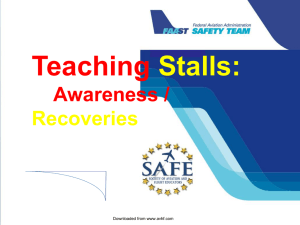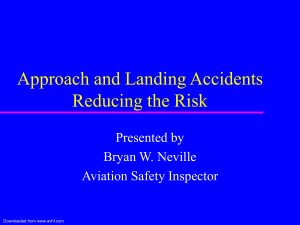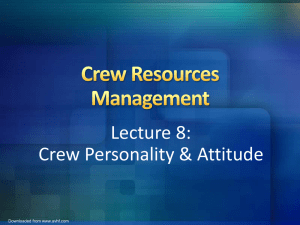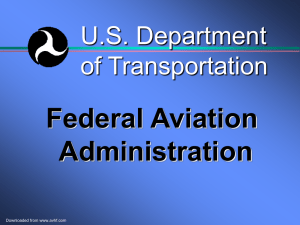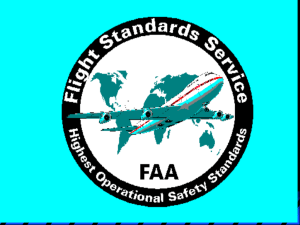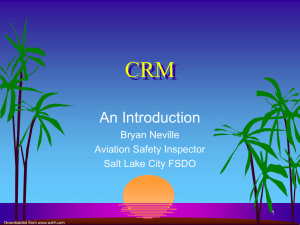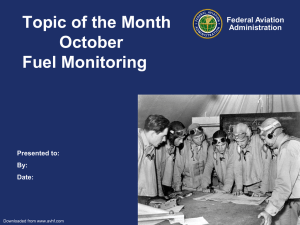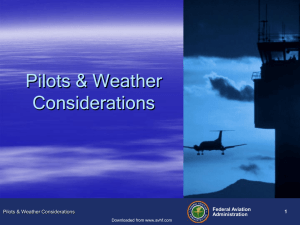How To Teach Flying - Aviation Human Factors
advertisement
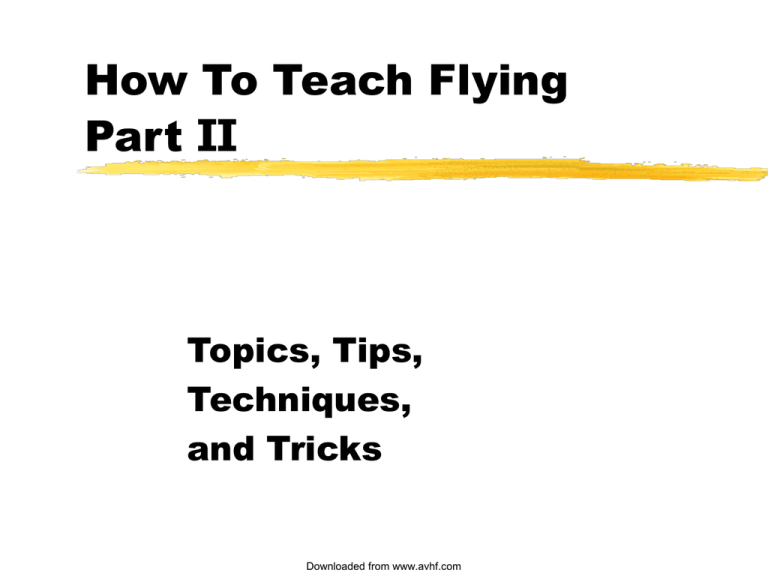
How To Teach Flying Part II Topics, Tips, Techniques, and Tricks Downloaded from www.avhf.com Topics . . . Forces Acting on an Airplane in Flight Turning Tendencies Airplane Stability Loads and Load Factors Airplane Structure Flight Control Systems Electrical Systems 2 Downloaded from www.avhf.com More Topics . . . Engine Operation Propeller Aircraft Documents, Maintenance, and Inspections Flight Instruments Pitot-Static Systems Gyroscopic Systems Magnetic Compass 3 Downloaded from www.avhf.com More Topics . . . Weight and Balance Airplane Performance Weather Airport Operations Airspace Navigation Aeromedical Information 4 Downloaded from www.avhf.com More Topics . . . Preflight, Postflight Ground Operations Takeoffs and Climbs Basic Flight Maneuvers Slow Flight, Stalls, Spins Ground Reference Performance Maneuvers Airport Traffic Patterns Special Topics Approaches & Landings Faulty Approaches & Landings Flight by Instruments Night Operations Navigation Systems Emergency Operations Transition Training Aeronautical Decision Making 5 Downloaded from www.avhf.com Preflight Pilot Assessment Preflight Preparation Flight Planning Preflight Inspection Minimum Equipment List (MEL) Cockpit Management Use of Checklists 6 Downloaded from www.avhf.com Pilot Assessment AM I SAFE? A = Attitude M = Medication I = Illness S = Stress A = Alcohol F = Fatigue E = Eating (According to Airplane Flying Handbook) E = Emotions (According to AIM) 7 Downloaded from www.avhf.com Ground Operations Starting the Engine Hand Propping Standard Hand Signals by Line Crew Taxiing Taxi Speed Control Position in Winds Before Takeoff Check 8 Downloaded from www.avhf.com Takeoff Prior to Takeoff Rejected Takeoff Normal Takeoff Short Field Takeoff Best Angle-of-Climb Best Rate-of-Climb Flaps Landing Gear Takeoff Roll Lift-off Crosswind Takeoff Soft Field Takeoff Takeoff Roll Lift-off Weathervaning Noise Abatement Same for Rough Field Ground Effect 9 Downloaded from www.avhf.com Climbs After Takeoff Initial Climb Pitch Attitude Airspeed When to Retract the Landing Gear Runway Surface Remaining Reduce Drag Power Reductions Takeoff Path 10 Downloaded from www.avhf.com Basic Flight Maneuvers Integrated Flight Instruction Attitude Flying Straight-and-Level Flight Turns Climbs Descents 11 Downloaded from www.avhf.com Integrated Flight Instruction Outside Visual References The Use of Flight Instruments Not Instrument Flight! See and Avoid 12 Downloaded from www.avhf.com Attitude Flying Pitch Control Elevator Bank Control Ailerons Power Control Throttle Trim control Pitch Instruments Attitude Indicator Airspeed Indicator Altimeter Vertical Speed Indicator Rate Bank Instruments Attitude Indicator Turn Coordinator Direction, Rate, Quality 13 Downloaded from www.avhf.com Straight-and-Level Flight Constant Heading and Altitude Use Outside References Use the Nose Use the Wingtips Constant Airspeed Listen to the Noise 14 Downloaded from www.avhf.com Turns Shallow Turns Up to 20° of Bank Lateral Stability Tends to Level the Wings Medium Turns From 20° to 45° of Bank Tends to Remain at a Constant Bank Angle Steep Turns More Than 45° of Bank Overbanking Tendency Overcomes Stability 15 Downloaded from www.avhf.com More on Turns Total Lift is Split Vertical Component Opposes Gravity Horizontal Component Opposes Inertia Lowered Aileron Produces Greater Drag This Causes a Yaw Toward the Rising Wing Adverse Yaw Coordinated Rudder Use Overcomes Yaw 16 Downloaded from www.avhf.com More on Turns Rudder Should Streamline With Slipstream If Rudder is Maintained Airplane Will Skid to the Outside of the Turn If Opposite Rudder is Applied Airplane Will Slip to the Inside of the Turn Angle of Attack Must Be Increased To Maintain Altitude 17 Downloaded from www.avhf.com More on Turns What a Good Instructor Looks For in a Turn If the Nose Starts to Move Before the Bank Starts The Rudder Is Being Applied Too Soon If the Bank Starts Before the Nose Starts Turning, or the Nose Moves in the Opposite Direction The Rudder is Being Applied Too Late If the Nose Moves Up or Down When Entering a Turn Excessive or Insufficient Up-Elevator is Being Applied 18 Downloaded from www.avhf.com Climbs Normal Climb Constant-Pitch Attitude Constant Airspeed Cruise Climb Less Rate of Climb Increased Speed Better Engine Cooling Better Flight Visibility 19 Downloaded from www.avhf.com More on Climbs Engine Torque, and Asymmetrical Loading of the Propeller Roll and Yaw to the Left or Right? 20 Downloaded from www.avhf.com More on Turns Engine Torque, and Asymmetrical Loading of the Propeller Sometimes Called P-Factor Roll and Yaw to the Left 21 Downloaded from www.avhf.com More on Turns Engine Torque, and Asymmetrical Loading of the Propeller Sometimes Called P-Factor Roll and Yaw to the Left As the Nose is Climbing Gyroscopic Precession Yaw to the Left or Right? 22 Downloaded from www.avhf.com More on Turns Engine Torque, and Asymmetrical Loading of the Propeller Sometimes Called P-Factor Roll and Yaw to the Left As the Nose is Climbing Gyroscopic Precession Yaw to the Right 23 Downloaded from www.avhf.com More on Turns Engine Torque, and Asymmetrical Loading of the Propeller Sometimes Called P-Factor Roll and Yaw to the Left As the Nose is Climbing Gyroscopic Precession Yaw to the Right A Left Turn May Require Right Rudder! 24 Downloaded from www.avhf.com Descents Sometimes Called a Glide Effect of Weight on a Glide? If Two Aircraft have the Same Lift Over Drag Ratio (L/D), and At the Correct and a Constant Airspeed Higher Weight Gets There Sooner • Because a Higher Airspeed is Required for Max Glide Lower Weight Gets To the Same Point, but Later 25 Downloaded from www.avhf.com More on Descents With a Windmilling Propeller Pitch Controls Airspeed If Drag Increases Such as Lowering Gear and/or Flaps Airspeed Will Decrease Unless the Nose is Lowered 26 Downloaded from www.avhf.com More on Descents If the Nose is If the Nose is Not Lowered to Maintain Lowered and a Airspeed Reduced Airspeed is Maintained Glide Angle Increases, and Glide Angle Increases, and The Distance Traveled is Reduced The Distance Traveled is Reduced 27 Downloaded from www.avhf.com Slow Flight Defined as Flight at Any Airspeed that is Less Than Cruise Airspeed Maintain Altitude While Slowing Trim 28 Downloaded from www.avhf.com Stalls and Stall Recovery A Stall Can Occur at any Airspeed, in any Attitude, with any Power Setting Stall Awareness Vision Hearing Kinesthesia Control Pressures Stall Warning Indicators 29 Downloaded from www.avhf.com Stalls and Stall Recovery Stall Recovery Pitch Attitude and Angle of Attack Reduce Angle of Attack only Enough to Regain Lift Power Decreases Loss of Altitude Straight-and-Level Flight Maximum Lift 30 Downloaded from www.avhf.com Stalls and Stall Recovery Practice in This Order Approaches to Stalls Student Becomes Familiar with Indications of Approaching Stall Recover with No Power Demonstrates that Angle of Attack Ends the Stall Recover With Power Demonstrates that Power Reduces Loss of Altitude Full Stalls 31 Downloaded from www.avhf.com Stalls and Stall Recovery Power-Off Stalls Power-On Stalls Turning Stalls Practice in Different Configurations Landing Gear Up and Down Flaps Up and at Different Settings Consider the Falling Leaf Demonstration 32 Downloaded from www.avhf.com Stalls and Stall Recovery Proper Use of Controls in Stall Recovery Use of Aileron Requires Great Finesse Does Cause Adverse Yaw and Could Lead to a Spin The Rudder Use Must be Coordinated Rudder Will Control Yaw and Slip The Rudder Will Also Keep Wings Level The Elevator is Used to Recover from the Dive First, Pitch Down to Break the Stall Second, Pitch Downloaded Up tofromRecover From the Dive www.avhf.com 33 Stalls and Stall Recovery Factors Affecting Stalling Characteristics Balance Forward CG Increases Stalling Speed Bank Pitch Attitude Coordination Drag Power Weight Higher Weight Increases Stalling Speed Downloaded from www.avhf.com 34 Stalls and Stall Recovery Secondary Stalls Caused by Hastening the Recovery, or By Abrupt Use of the Controls Accelerated Stalls Refers to the Stall, not the Airspeed Stall Occurs More Rapidly and Severely May Be at a Higher Airspeed Generally Caused by Excessive Back-Elevator Pressure 35 Downloaded from www.avhf.com Stalls and Stall Recovery Cross-Control Stall Left Rudder, Right Aileron, Back Elevator Elevator Trim Stall Retard the Throttle, Mid-Range Flaps, Gear Down, Normal Glide Speed, Trim Then Advance Throttle to Maximum Without Stopping the Pitch-Up Recover Before the Stall Occurs 36 Downloaded from www.avhf.com Spins and Spin Recovery A Stall is a Requirement for a Spin No Stall - No Spin! How Do You Know Which Direction the Airplane is Spinning? Check the Turn-and-Slip Indicator Not the Ball! What is Happening if the Airspeed is Increasing? It’s a Spiral, Not a Spin! 37 Downloaded from www.avhf.com Ground Reference Maneuvers Place an “X” at the point on the circle where the bank angle is the greatest during a turn around a point with the wind as shown. Let’s assume lefthand turns. Direction of Flight Wind 38 Downloaded from www.avhf.com Ground Reference Maneuvers Place an “X” at the point on the circle where the bank angle is the greatest during a turn around a point with the wind as shown. Let’s assume lefthand turns. Direction of Flight Wind 39 Downloaded from www.avhf.com Ground Reference Maneuvers Place an “X” at the point on the circle where the bank angle is the greatest during a turn around a point with the wind as shown. Let’s assume lefthand turns. Direction of Flight Wind 40 Downloaded from www.avhf.com Ground Reference Maneuvers Place an “X” at the point on the circle where the bank angle is the greatest during a turn around a point with the wind as shown. Let’s assume lefthand turns. Direction of Flight Wind 41 Downloaded from www.avhf.com Ground Reference Maneuvers Private Pilot Rectangular Course Left and Right S-Turns Across a Road Turns Around a Point More Than One Turn! Commercial Pilot Eights on Pylons 42 Downloaded from www.avhf.com Ground Reference Maneuvers Enter Downwind Choose an Airspeed Below Va What Altitude Do We Select? 600 to 1,000 feet AGL Choose a Location That Has a Suitable Place to Land, If That Should Become Necessary Low Altitude Limits the Time Needed to Look for a Place to Land if the Engine Quits 43 Downloaded from www.avhf.com Performance Maneuvers Private Pilot Steep Turns Commercial Pilot Steep Spirals Chandelles Lazy Eights 44 Downloaded from www.avhf.com Performance Maneuvers Bank Must Not Exceed 60° Load Factor at 60° is 2-Gs Load Factor at 70° is 3-Gs General Aviation Airplanes are Typically Rated for 3.8-Gs At What Airspeed Will An Airplane Stall in a 60° Bank if it Stalls at 60 knots in Level Flight? 45 Downloaded from www.avhf.com Performance Maneuvers Bank Must Not Exceed 60° Load Factor at 60° is 2-Gs Load Factor at 70° is 3-Gs General Aviation Airplanes are Typically Rated for 3.8-Gs At What Airspeed Will An Airplane Stall in a 60° Bank if it Stalls at 60 knots in Level Flight? 85 knots! 46 Downloaded from www.avhf.com Airport Operations Ground Operations Signage and Lighting Traffic Pattern Operations Entry, Exit, Altitude, Airspeed Towered Airports Who’s In Charge? Non-Towered Airports Standard Procedures Are Good! 47 Downloaded from www.avhf.com Special Topics Positive Aircraft Control Positive Exchange of Flight Controls Stall/Spin Awareness Collision Avoidance Wake Turbulence Avoidance Land and Hold Short Operations (LAHSO) Runway Incursion Avoidance Controlled Flight into Terrain (CFIT) Aeronautical Decision Making (ADM) Checklist Usage 48 Downloaded from www.avhf.com Approaches and Landings Normal Approach Crosswind Approach Base Final Approach Roundout (Flare) Touchdown After-Landing Roll Base Final Approach Roundout (Flare) Touchdown After-Landing Roll 49 Downloaded from www.avhf.com Approaches and Landings Go-Arounds (Rejected Landings) Slips Forward Slips Normally Used to Increase Decent Angle Without an Increase in Airspeed Side Slips Normally Used to Approach in a Crosswind to Counteract Wind Drift Hydroplaning • Speed = 8.6 Times the Square Root of the Tire Pressure 50 Downloaded from www.avhf.com Approaches and Landings Turbulent Air Approach Wind Shear and Gusts Consider Less Than Full Flaps Airspeed Suggestion Normal Approach Speed plus 1/2 the Gust Reduce Power to Idle Only After the Mains are Firmly on the Ground 51 Downloaded from www.avhf.com Approaches and Landings Short Field Approach Requires Precise, Positive Control of the Rate of Descent and Airspeed Excessively Low Airspeed Will Result in a Hard Landing Back Side of the Power Curve Soft Field Approach Final Approach Speed Is the Same as For the Short Field Approach A Steep Angle of Decent is Not Necessary and May be Counterproductive Hold it Off but Don’t Plop it Down! 52 Downloaded from www.avhf.com Approaches and Landings Power-Off Accuracy Approaches and Landings New Commercial PTS Requires 180° Approach and Landing Within 200 Feet Develops Judgement in Estimating Distances and Glide Ratios 53 Downloaded from www.avhf.com Faulty Approaches & Landings Low Final Approach High Final Approach Slow Final Approach Fast Final Approach High Flare Late (or Rapid) Flare Floating Ballooning Bouncing Porpoising Wheelbarrowing Hard Landing Touchdown in a Drift or Crab Ground Loop Wing Rising after Landing 54 Downloaded from www.avhf.com After Landing and Postflight After Landing but Still on the Runway Clear of the Runway Parking Engine Shutdown Securing Servicing 55 Downloaded from www.avhf.com Flight By Reference to Instruments Straight-and-Level Flight No Bank Level Pitch Descents, Climbs, Turns Unusual Flight Attitudes Navigation Systems Use of Radar Services 56 Downloaded from www.avhf.com Night Operations Understand Night Vision Night Illusions Pilot Equipment Airplane Equipment Preparation and Preflight 57 Downloaded from www.avhf.com Navigation Systems VOR Navigation DME ADF Navigation LORAN Navigation GPS Navigation What About Good ‘Ol Pilotage? What Is Ded Reckoning? 58 Downloaded from www.avhf.com Emergency Operations Loss of Power Electrical Landing Gear Other Systems Fire During Start In Flight Open Door Split Flap Condition Emergency Equipment and Survival Gear Emergency Landing Smoke 59 Downloaded from www.avhf.com Aeronautical Decision Making Decision Making Without Time Constraints-Preflight Generally Leads to Better Decisions With Time Constraints-In Flight Contributes to Poor Decision Making • Unless the Pilot is Trained to React Appropriately 60 Downloaded from www.avhf.com Aeronautical Decision Making “Flying is a wondrous adventure, but it is not the place for boldness, thrill seeking, complacence, or a lack of dedication to doing the best one can.” – Airplane Flying Handbook, page 18-2 61 Downloaded from www.avhf.com Transition Training Airplanes With More Than Two Seats High Performance Airplanes Pressurized Airplanes Multiengine Airplanes Seaplanes Skiplanes Tailwheel Airplanes How About the Instrument Rating? Downloaded from www.avhf.com 62 Summary There’s a lot to know and practice. Don’t short-change the student. You’ve all Heard the Saying “Three Things That Are No Good to a Pilot: Runway Behind Fuel in the Fuel Truck, and Altitude Above Let Me Add Two: Knowledge Not Learned & Skill Not Practiced 63 Downloaded from www.avhf.com
